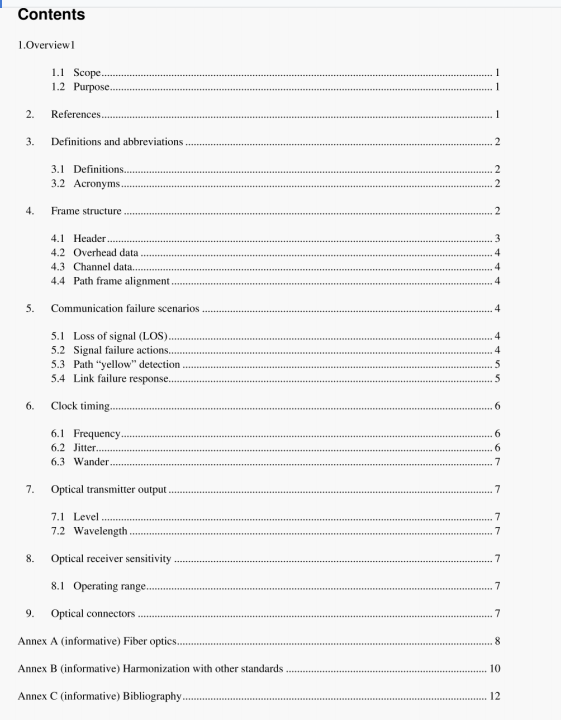IEEE Std C37.94:2002 pdf free download.IEEE Standard for N Times 64 Kilobit Per Second Optical Fiber Interfaces Between Teleprotection and Multiplexer Equipment.
Harmonization with other standards
B.1 Harmonization with IEC standards and ITU recommendations
B.1.1 Introduction
As far as could be determined by the working group, there was no suitable IEC standard, or work toward such a standard: however, there were some ITU recommendations that have been considered.
B.1.2 ITU G.704 recommendation for Frame Structure
ITU G.704 section 2.3 1B41 specifies a recommended frame stmcturc for 2048 kbiils interlaces.
Comments:
This document is compliant with 0.704. specifically including the use of hit #3 in the non-frame-alignment section of the header for RDI or “Yellow” bit.
The “CRC-4” and “Synchronization Status Messages” options of 0.704 are not mandatory and are not supported in this standard.
B.1.3 ITU G.706 recommendation for loss of frame (LOF)
Comments:
This IEEE standard uses only the one term “LOS” to denote Loss of Signal. whether due to a low or no received power level, or due to a bad data pattern caused by some electronic failure.
LOS is declared upon receiving two or more enors in eight consecutive framing patterns, and cleared upon receiving eight consecutive correct framing patterns.
These algorithms are simpler to implement. and clearer to understand, than those for LOF in G.7.
B.1.4 ITU G.775 recommendation for LOS
[lU G.17 seclion 4.2 iI sPecihes recommended algorithms for declaring “LOS” condition.
LOS for 2048 khit!s interfaces, is declared when the received signal power has dropped below a level “Q” for between 10 and 255 UI.
Comments:
This IEEE standard uses the absence of a corect framing pattern to declare LOS.
LOS is declared upon receiving two or more errors in eight consecutive framing patterms, and cleared upon
receiving eight consecutive correct framing patterns.
These algorithms are simpler to implement, and clearer to understand, than those for LOS in G.775; they are
also more appropriate in view of the more robust framing pattern used, and the failure mode of fiber versus
copper cables.
B.1.5 ITU G.775 recommendation for RDI
ITU G.775 section 6.2 [B6] specifies recommended algorithms for RDI condition.
An RDI defect at 2048 kbit/s path termination functions is detected when the incoming signal has
the“Remote alarm indication” bit set to binary ONE (“1″) for z consecutive double frame periods,
where z= 2.5. Z is not provisional.
The RDI defect is cleared when the incoming signal has the“Remote alarm indication” bit set to
binary ZERO (“0″) for z consecutive double frame periods.
Comments:
This IEEE standard continues the use of a path “Yellow” terminology instead of the recently introduced term
“RDI” to denote a far-end alarm status.
The algorithm specified complies with this G.775 recommendation.
IEEE Std C37.94:2002 pdf free download
